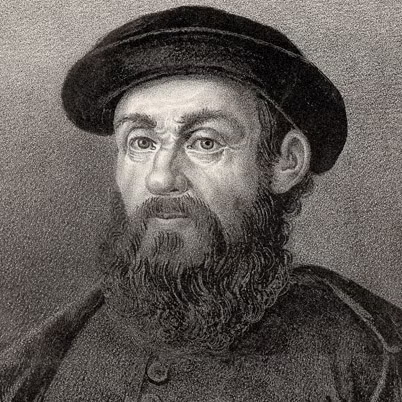
Table of Contents
Who Was Ferdinand Magellan?
Ferdinand Magellan, a pioneering explorer of the Age of Discovery, is best known for his ambitious expedition that led to the first circumnavigation of the globe. Born around 1480 in Portugal, possibly in Porto or Sabrosa, he hailed from a noble family. Following the death of his parents, Magellan became a page at the court of Queen Leonora, where he was immersed in the study of mapmaking and navigation. By his mid-20s, he had gained significant experience sailing in large fleets and engaging in military conflicts.
In 1519, with the backing of Holy Roman Emperor Charles V, Magellan embarked on a quest to discover a more efficient route to the Spice Islands. He organized a fleet of ships for this ambitious undertaking. Despite facing numerous challenges, including substantial setbacks and ultimately his own death during the voyage, Magellan’s expedition successfully completed the circumnavigation of the Earth, significantly enhancing global maritime knowledge and trade routes.
Early Life
Ferdinand Magellan was born into the Portuguese nobility, a background that afforded him educational opportunities and connections. At the age of ten, he became a page in the royal court, where he attended Queen Leonora’s School of Pages in Lisbon. There, he immersed himself in studies focused on cartography, astronomy, and celestial navigation—disciplines that would prove invaluable in his later explorations. Magellan’s early education laid the foundation for his future as a navigator and explorer, ultimately shaping his significant contributions to the field of exploration.
Navigator and Explorer
In 1505, at the age of 25, Ferdinand Magellan joined a Portuguese fleet bound for East Africa. By 1509, he had participated in the pivotal Battle of Diu, where the Portuguese navy decisively defeated Egyptian vessels in the Arabian Sea. Two years later, Magellan explored Malacca, located in present-day Malaysia, and took part in the conquest of its strategic port. During this expedition, he acquired a native servant named Enrique. It is believed that Magellan may have ventured as far as the Moluccas—now known as the Spice Islands of Indonesia—which were the original source of valuable spices such as cloves and nutmeg. This region became a focal point of intense European competition for trade.
While stationed in Morocco in 1513, Magellan sustained a serious injury that resulted in a permanent limp. Following his recovery, he faced allegations of illegal trading with the Moors. Despite his lengthy service to Portugal and his repeated appeals to the king, he found himself without further opportunities for advancement. In 1517, Magellan relocated to Seville, Spain, to offer his navigational expertise to the Spanish court. This decision coincided with a critical moment in history; the Treaty of Tordesillas (1494) had delineated territorial claims, assigning all lands east of the demarcation line to Portugal and those to the west to Spain. Over the subsequent three years, Magellan diligently studied the latest navigation charts. Armed with knowledge of the Earth’s spherical shape, derived from ancient Greek texts, he conceived a bold plan to find a shorter route to the Spice Islands by sailing west across the Atlantic, navigating around South America, and traversing the Pacific Ocean. While this concept was not entirely novel—having been previously considered by Christopher Columbus and Vasco Núñez de Balboa—Magellan’s proposed route would enable Spain to access the Spice Islands without traversing Portuguese-controlled territories.
Final Years and Death
Magellan presented his ambitious plan to King Charles I of Spain, who granted his approval. On September 20, 1519, Magellan set sail with a fleet of five ships, albeit poorly equipped for the vast distances they were to cover. The fleet first navigated to Brazil and then southward along the coast of South America to Patagonia, where an attempted mutiny resulted in the wreckage of one ship. Nevertheless, the expedition continued with the remaining four vessels.
By October 1520, Magellan and his crew had entered what is now known as the Strait of Magellan. The passage took over a month to complete, during which the captain of one of the ships deserted and returned home. The remaining vessels then set sail across the Pacific Ocean, arriving at Guam in March 1521.
Later that month, Magellan’s fleet reached Homonhom Island in the Philippines with fewer than 150 men remaining from the original 270. Here, he established trade relations with Rajah Humabon, the island’s king, which quickly led to deeper involvement in local conflicts. Tragically, Magellan was killed in battle on April 27, 1521.
Following his death, the remaining crew managed to escape the Philippines and continued their journey to the Spice Islands, arriving in November 1521. The commander of the last ship, the Victoria, set sail in December and successfully reached Spain on September 8, 1522.
The Controversy Over Who Was First
The question of who first circumnavigated the globe has generated significant debate. The most widely accepted answer points to Juan Sebastián Elcano and the surviving crew members of Magellan’s fleet, who set out from Spain on September 20, 1519, and returned in September 1522. However, another contender for this title is Enrique, Magellan’s servant. Enrique had accompanied Magellan on his earlier voyage to the Spice Islands in 1511 and was present in the Philippines a decade later. Following Magellan’s death, Enrique reportedly experienced profound grief and, upon realizing he would not be freed, escaped into the wilderness.
The historical record becomes unclear at this point. Some accounts suggest that Enrique fled into the forest, while official Spanish records indicate he was among those massacred in an attack. However, historians have questioned the reliability of these records, noting a potential bias against Indigenous peoples. If Enrique did survive and returned to Malacca, where he had been enslaved in 1511, it could imply that he, rather than Elcano and the remaining crew members, was the first person to circumnavigate the globe, albeit not in a single continuous voyage.
